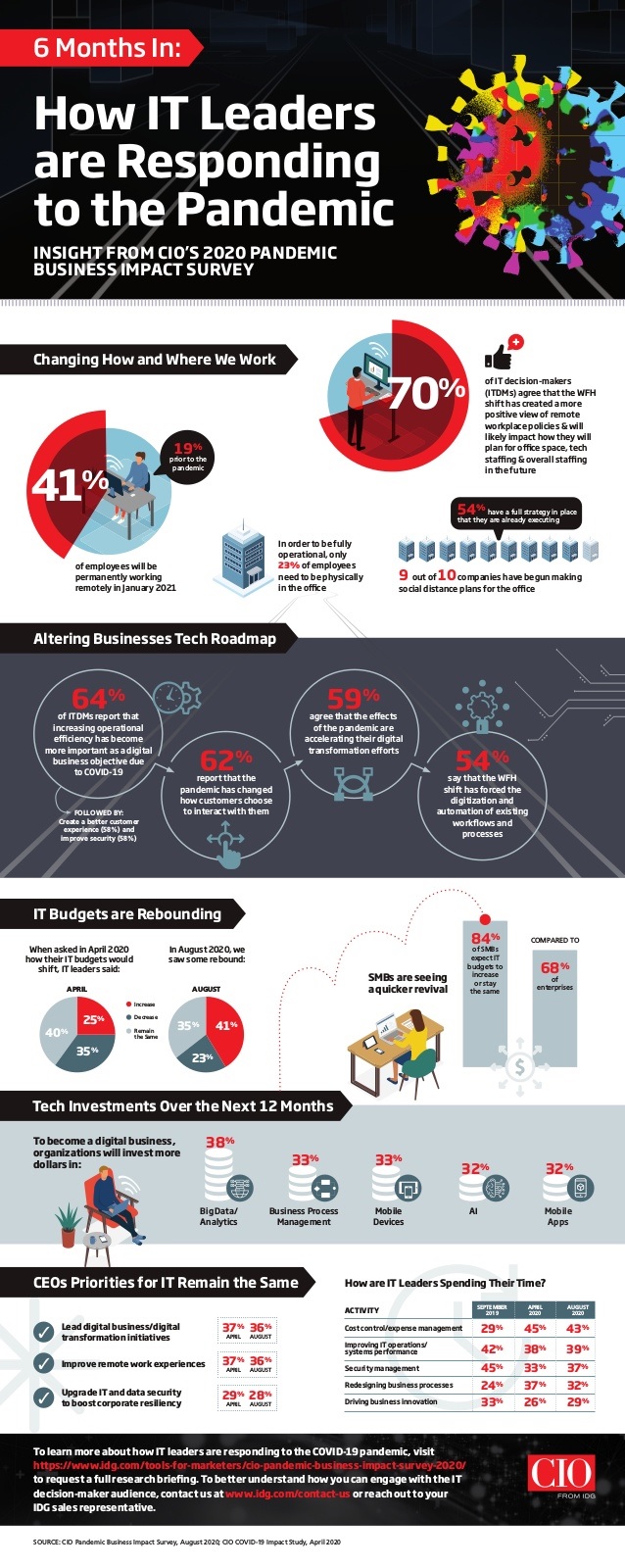Although cost control/expense management remains top of mind, organizations are realizing the necessity of technology solutions to enable them to steer the business during these turbulent times, according to IDG's CIO Pandemic Business Impact Study.
Tech Budgets See a Resurgence
In March, when the pandemic first hit US organizations, there was some concern with how IT budgets would change year over year. CIO's COVID-19 Impact Study reflected that uncertainty with 35% of organizations expecting their IT budgets to decrease in the next 12 months, (up from just 7% in December 2019).
The good news is that budgets are swinging back as organizations realize the value and need of new technology solutions. Latest results show that 41% of organizations anticipate their IT budgets will increase in the next 12 months, 35% expect them to remain the same, and only 23% anticipate a decrease.
Supporting this budget growth is the fact that 59% of IT decision-makers (ITDMs) say that the effects of the pandemic are accelerating their digital transformation efforts.
Looking at what is driving IT strategy, 32% say responding to internal events (i.e. process changes), 29% say responding to external events (i.e. market changes), and 35% say status quo tasks/keeping the lights on.
Also, more than half (54%) say they are adding new technology projects to their 2020 roadmap to create a competitive advantage given shifts in their industry due to the pandemic.
"As organizations continue to drive business, address customer needs, and support their workforce in these challenging times, it's inevitable that new technologies and solutions will need to be evaluated and put in place for companies to evolve," said Sue Yanovitch, VP of Marketing, IDG Communications, Inc. "Whether it be additional collaboration tools, security controls, or analytics programs, many IT leaders are having to shift their processes and roadmap due to great disruption."
Digital Business Continues to be a Top Priority
While IT leaders are seeing their digital transformation efforts accelerate due to the pandemic, this is aligned with CEOs' top priority for IT which is to lead digital business/transformation initiatives (36%).
From the April 2020 results, this priority has remained in the top spot, tied with improving remote work experience (36%), and followed closely by upgrading IT and data security to boost corporate resiliency (28%).
Looking at where IT leaders are spending more time compared to three months ago, they may be moving past their initial conservative reaction and regaining a strategic focus. For example, a greater percentage (29%) say they are driving business innovation compared with only 26% in April; and 27% say they are spending their time developing new go-to-market strategies & technologies, compared with only 22% in April.
New to this study, CIO asked ITDMs how their digital business objectives have changed in importance as a result of the pandemic. Close to two-thirds (64%) said that increasing operational efficiency rose in importance, followed by creating better customer experiences (58%), and improving security (58%). The pandemic has certainly shifted goals around a DX strategy.
Technology Investments Due to COVID-19
Organizations are adding new technologies to support the shift in work environments and priorities. Compared to three months ago, organizations plan to spend more on big data/analytics, business process management, mobile devices, artificial intelligence (AI), and mobile applications in order to become a digital business.
When asked to think about their likely purchases over the next 6-12 months, the majority of tech leaders expect them to be additions/brand new tech solutions (52%). Out of these additions, 34% are being planned for regardless of recent events and 18% are being made specifically due to recent events (i.e. pandemic). Following additions, 27% say their purchases will be made as upgrades, and 21% as replacements of existing technology.
"IT leaders need to continue to network with and learn from their peers. With the lack of face-to-face opportunities, they are turning to a variety of virtual offerings," said Yanovitch. "Whether that be an educational webcast or webinar, conversational networking event, or multiple day virtual tradeshows, these platforms provide tech decision-makers the opportunity to connect, learn and bring new solutions and best practices back to their organizations."

